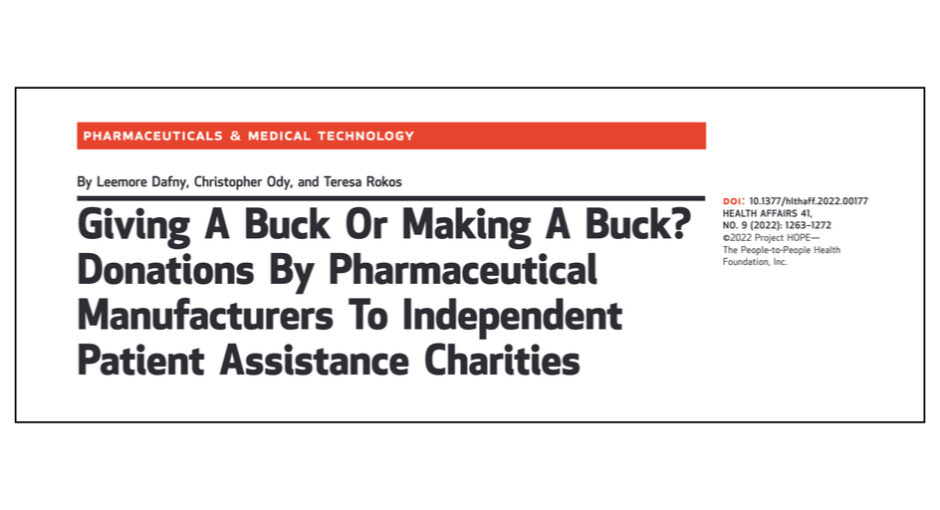In a new study published in Health Affairs, researchers find that drug manufacturers are likely to profit from donations they make to patient assistance charities that help patients cover out-of-pocket costs associated with expensive treatments for serious and often rare conditions. By designating these donations to help with costs associated with certain medical conditions, manufacturers are able to effectively subsidize the purchase of their own drugs, which study authors say violates the “spirit” of the federal anti-kickback statute.
The study, published on Sept. 6, was authored by Leemore Dafny, Professor of Business Administration at Harvard University, Christopher Ody, Assistant Professor of Health Enterprise Management at Northwestern University, and Teresa Rokos of University of Southern California. Dafny currently serves as an expert for the U.S. Justice Department where she consults on allegations connected to pharmaceutical manufacturers’ relationship with copay assistance charities.
Researchers analyzed claims data for roughly one third of Medicare Advantage (MA) beneficiaries between 2010 and 2017 in combination with data on conditions covered by the seven largest independent patient assistance charities in operation those same years. They calculated out-of-pocket costs for relevant medications and manufacturers’ revenues on claims likely to be eligible for assistance, and were thus able to evaluate manufacturer incentives—or the potential for increased profits—in exchange for donating funds to treat certain conditions.
Study authors found that donations made by the leading manufacturer of drugs for each condition funded by patient assistance charities were likely to be profitable, even if relatively few patients were induced to use the manufacturer’s drugs as a result. This was especially true for the 10 most costly conditions, for which the leading manufacturer accounted for 67% of sales in 2010 and 89% in 2017 on average. These conditions include gastrointestinal stromal tumors, multiple myeloma, hepatitis C, Wilson’s disease, and hereditary angioedema, among others, with out-of-pocket costs for treatment reaching tens of thousands of dollars annually.
Previous research has shown that patient abandonment of prescriptions rises in proportion to cost-sharing, suggesting that eliminating cost-sharing would increase revenues by boosting the likelihood that patients will fill prescriptions. Based on this premise, researchers analyzed data on patient abandonment of prescriptions at varying levels of cost-sharing alongside data on cost-sharing per assistance-eligible claim, in order to estimate the increase in top manufacturers’ revenues generated by removing patient cost-sharing. They found that the top manufacturer in the average condition could expect an increase in revenues of 31% in 2010 and 36% in 2017 if it donated funds sufficient to cover all of patients’ cost-sharing for all drugs in the relevant condition.
Drug Industry Perspective
Katie Koziara, Director of Public Relations of PhRMA, defends manufacturer contributions to assistance charities, which pass those funds to patients in the form of coupons or other means. “Too many insured patients face high out-of-pocket costs for brand medicines because of insurer-imposed barriers like high deductibles and coinsurance, which shift the cost of life-saving care onto patients. Coupons help eligible, commercially insured patients afford their out-of-pocket costs to obtain the medicines they need. In fact, the share of patients staying on treatment for one year increased by up to 47% when patients used copay coupons,” Koziara told 340B Report.
By contrast, study authors say assistance programs “weaken manufacturers’ incentives to accept lower prices from insurers. By undermining patient cost sharing, assistance programs leave insurers with a less effective tool kit for steering utilization and containing spending.”
The scope and footprint of patient assistance charities has grown significantly between 2010 and 2017, the study found. The number of conditions covered increased from 87 in 2010 to 154 in 2017. The share of MA enrollees with a claim for at least one assistance-eligible drug rose from 29% to 41% during that timeframe and the percentage of MA spending on assistance-eligible drugs increased from 25% to 38%. The proportion of cost-sharing for these drugs increased from 19% to 30%.
The federal anti-kickback statute prohibits the use of monetary incentives that generate greater spending by a federal healthcare program such as Medicare, so drug companies are prohibited from paying a patient’s cost-sharing directly. They are, however, allowed to donate to patient assistance charities and earmark those donations to go toward specific diseases, per guidance from the U.S. Department of Health and Human Services Office of Inspector General (HHS OIG) which governs these assistance programs.
OIG guidance stipulates that charities may not “artificially define their disease categories so narrowly that the earmarking effectively results in the subsidization of…donors’ particular products” and assistance should be provided “without regard to the beneficiary’s choice of product.” Patients must also demonstrate financial need in order to qualify.
PhRMA’s Koziara notes that “federal law doesn’t prohibit coupons [or other copay assistance] in the commercial market, and the OIG…has issued extensive guidance to govern manufacturer contributions to charitable foundations.”
“Studies that call into question coupons threaten to put up additional barriers between patients and the medicines they need,” Koziara says.
Study authors disagree. “Current federal guidance is insufficient to ensure that manufacturers are not earning kickbacks from their donations to patient assistance foundations; this guidance should be rescinded or substantially revised,” they say.
Patient assistance charities are majority funded by pharmaceutical companies. Total annual contributions peaked at $1.85 billion in 2018 and have fallen off somewhat since then, likely as a result of several successful lawsuits filed by the Department of Justice (DOJ) for violations of OIG guidance in the form of improper information sharing between charities and manufacturers. This resulted in the latter receiving illegal kickbacks from their donations, study authors note.
Patients using assistance charities to cover out-of-pocket costs for expensive medications are typically either insured through Medicare or the commercial market. Medicaid-funded or dually eligible patients experience very low or no cost-sharing, and uninsured patients are eligible to access other fully-funded assistance programs offered by manufacturers directly, which they are also able to benefit from via tax write-offs.


